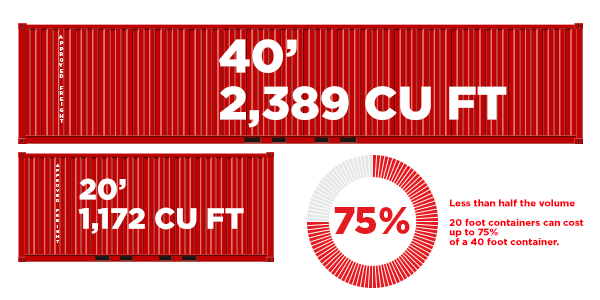When you’ve got a less-than-container load (LCL), you might find yourself considering a 20′ container. Clocking in at just about half the cubic volume of a standard 40′ container, a 20′ container may seem perfect for you if you can’t fill a dedicated 40′ one.
However, many carriers are phasing out this option, and we’ve got three reasons you might want to reconsider, too. We’ll walk you through the “why” in this article. We’ll also offer you some LCL alternatives that will not only save you money but will also save you some valuable shipping time.
Reason #1: 20′ Containers Aren’t Cost-Efficient
Since a 20′ container holds half the freight of a 40′ container, you might think that a 20′ container costs half as much. However, in reality, you’ll probably pay up to 75% of the cost of a 40′ container to ship a 20′ one.
There are a couple of reasons behind this:
1. 20′ containers require special equipment and handling for loading. As a result, freight carriers charge more for this specialized service.
2. There’s more value in shipping a larger quantity. Or, to put it a different way, when you buy more, you’re more likely to get a better deal. Think about the difference between buying a single can of Coke at the store compared to the cost of a six-pack. Then compare that to the cost of a 24-pack you might get at a big box store. Buying freight offers similar parallels: The more you buy, the better rates you’ll get.
Reason #2: 20′ Containers May Take Longer to Ship
In addition to costing more, 20′ containers often move more slowly than 40′ containers, especially if they need to move by rail at any point.
Freight carriers require 20′ containers to move by rail in pairs. As a result, if no one else is shipping a 20′ container at the same time, your container will sit in the warehouse until another comes along. This may end up delaying your shipment considerably, possibly even for weeks.
Additionally, as we mentioned, many carriers are phasing out 20′ containers or discouraging their customers from using them. This means your shipment may wait even longer before the second half of its pair appears on the scene.
That being said, we’ve got good news when it comes to LCL shipments.
Reason #3: You’ve Got Better Options
First things first: Every shipment is different. A good freight forwarder will recognize this and create a custom solution for your budget and timeline.
That being said, when we speak to our clients who are considering 20′ containers, we generally offer two alternatives:
Option #1: Purchase 20′ of space in a 40′ container. We’ll bring the container to you and you can load it with 20′ of freight. Then, we’ll return it to our warehouse, backfill it with consolidated freight that’s headed for the same destination and send it on its way.
Option #2: Let us handle the consolidation from start to finish. We’ll come to you, pick up your freight and consolidate it in our warehouse, then get it on its way once we have a complete load.
Either one will likely offer you 1) a more economical option that 2) arrives more quickly than a 20′ container.
The bottom line? If you’re willing to be a little more flexible around the “how” the logistics of your shipment, you can save yourself some time and money.
Exploring Your Options
At the end of the day, your best bet is to work with an experienced freight forwarder who can share a range of options with you.
Tell your forwarder about your:
- Budget
- Desired timeline
- Extra considerations – Are you worried about the security of your freight? Handling of expensive goods? Distribution to your individual stores?
By keeping an open mind around the logistics while sharing any concerns, you’ll help your forwarder create the right LCL solution for you.
We’d be happy to help! If you’re looking for solutions for your LCL shipments, reach out to us. We’ll help you explore your options to find the solution that fits your timeline and your budget.
Get a Free Quote


